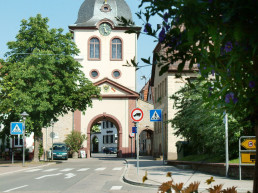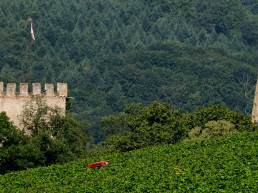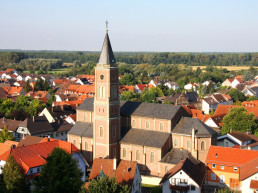Castle
Explore Bruchsal Castle, built in baroque style, with one of the most beautiful castle gardens in Germany.
Core city
The old town and the connected modern city center offer shopping, culture and varied gastronomy.
Guides
The 5 districts of Bruchsal
Each of these districts has its own character, its own center and its own cultural life. Experience the medieval town centers of the districts of Heidelsheim and Obergrombach.
Büchenau district
Numerous lovingly renovated half-timbered houses characterize the image of the village street “Au in den Buchen”. The Büchenau home parlor is located in the old school in Büchenau, with a large private collection of local and craft history objects. In Büchenau, asparagus has been growing on the healthy sandy soils since 1952. The “white gold” is particularly delicate there, because all fields are in the water protection area and therefore very little fertilization is used.
The Büchenau Asparagus Festival takes place legendarily in the asparagus season. Hidden treasures include the Easter fountain at the bird park in the middle of the village, which is lovingly designed by the citizens every year, as well as the village church, built in 1745 and destroyed in 1945, on which an onion dome originally sat. A popular destination for cyclists and hikers is the Maria-Hilf-Chapel on Neutharder Straße, inaugurated in 1864, where the Virgin Mary, Saints Joseph and St. Wendelin and the 14 helpers in need give people peace and comfort.
Heidelsheim district
In 1774 Heidelsheim is the “Imperial City of Heidolfesheim”. Until the 19th century, Heidelsheim remained a walled “closed” city with four fortress towers that could only be entered through four gates. The cat and thief tower still give Heidelsheim the image of a former place fortified city and also the medieval floor plan with dense buildings and narrow streets can still be seen clearly. The spacious market square with its mighty fountain is surrounded by venerable town houses and an avenue of broad-crowned chestnut trees.
During city tours with Rosa and Türmer tours, history comes alive again and again. The local history museum in the town gate can be visited from March to October every second and fourth Sunday of the month from 2 p.m. to 5 p.m. and by appointment.
The “Historical Reichsstadtfest” takes place every uneven year. On the afternoon of Easter Sunday, young and old meet at the traditional Higgo market with the “Eierhiggen” to beat boiled eggs against each other in good company, a special Easter custom. Whose egg remains whole wins.


District Helmsheim
In 769 the place name Helmsheim was mentioned for the first time in the deed of donation of the Lorsch Monastery. Thanks to donations from the sovereigns and the churches, what was then “Helmolvesheim” had an eventful history. Archaeological finds from different time periods bear witness to the settlements of the Celts, Romans and Alemanni.
The foundation stone for the baroque church of St. Sebastian was laid in 1753, and its interior design combines several epochs.
In the wine press built in 1782, which was later used as the community bakery, the “wine press festival” takes place every two years, a highlight of the festive activities in Helmsheim.
The old oven is still fully functional and is heated up on special occasions.
If you are looking for peace and relaxation, you will also find it here in the typical hilly location of the Kraichgau, vineyards and orchards invite you to take long walks.
District Obergrombach
As soon as you step under the archway on Rathausplatz, you are in the middle of the past, in the historic “Städt’l”, one of the more important medieval town centers in Baden-Württemberg. On their own initiative, citizens and an artist designed the half-timbered houses there in an exceptionally artistic way.
The Marienburg, built around 1200, towers over the roofs of Obergrombach. Cardinal Damian Hugo von Schönborn, Prince-Bishop of Speyer, had the so-called “Lower Castle” expanded as a summer residence in 1723. Today the castle is privately owned and can always be visited in the even years during the traditional castle festival. The castle chapel with its wall frescoes on the story of salvation, passion and martyrs is an art-historical gem.


District Untergrombach
The 269 meter high Michaelsberg is eponymous for a Neolithic culture, the “Michelsberg culture”, approx. 3500 – 2600 BC. It is a fortified hilltop settlement with a special wall-ditch system that protected against enemy attacks. The Michaelskapelle is mentioned in writing for the first time in 1346. It was dedicated to the Archangel Michael. It was built in its present form in 1742-44 by Cardinal Damian Hugo von Schönborn, Prince-Bishop of Speyer.
The Michaelsberg is also a natural paradise with rare plants and animals. Several signposted circular routes begin at the chapel and lead to beautiful spots: terraces and dry stone walls, sunken paths, steps, to fruit trees and meadows.
Down in the “valley” you will find the so-called ridge column house from 1428, the oldest half-timbered house in Kraichgau. Here each room of the local history museum takes you back to a different time, tells a different story, e.g. about the career of the farmer’s guide Joß Fritz. The peasant leader, born around 1470 in “Grumbach”, fought for the rights and human dignity of the peasants, resisted the feudal lords and planned uprisings in the region of the bishopric of Speyer, near Freiburg and in Alsace at the beginning of the 16th century. He became the symbol of the “Bundschuh” uprising.


